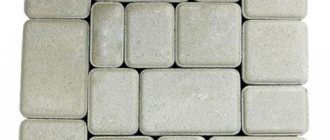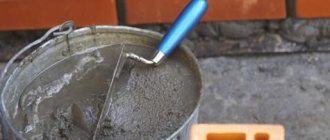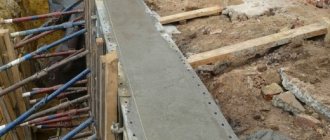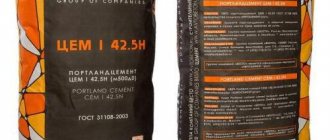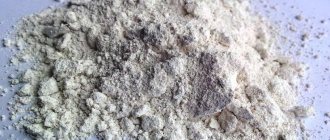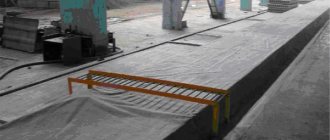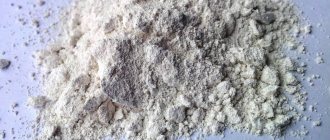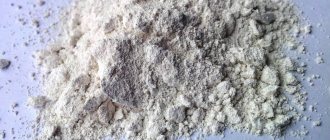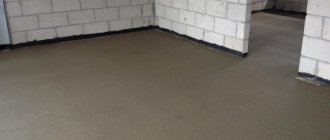The name “white cement” speaks for itself - this type of binder is characterized by a high degree of whiteness and purity of the components; due to its excellent decorative properties, it is recommended to be used for finishing work. This building material is considered a relative novelty and is currently presented on the market mainly by imported manufacturers. The manufacturing technology and raw materials differ from traditional ones, which has a positive effect on the hardening time and such performance characteristics as: strength, frost and weather resistance, crack resistance.
The use of cement in construction speeds up work and allows you to create unique decorative elements and structures. At the same time, this is a rather expensive type of binder with its own mixing characteristics; violation of the recommended proportions, incorrectly selected tools or unwanted impurities lead to stains on the surface or deterioration in color quality. On the other hand, if the basic nuances are observed, an amazing effect is obtained and the price of the product is completely justified.
What is white cement?
Its color and high-quality structure are achieved through a combination of special raw materials and innovative crimping and grinding technologies. The basis is low-iron clinker made from kaolin clay; additives include gypsum, chalk (limestone), and chlorine salts. All substances included in the composition contain a minimum number of iron oxides or pigment inclusions. After calcination to 1200–1400 °C, the clinker is subjected to rapid cooling; such hardening helps to increase the strength and frost resistance of the future cement.
An important nuance: the stoves use environmentally friendly heating methods; during combustion, soot or ash is not released (or carefully captured). Grinding is carried out in mills equipped with basalt, silicon or porcelain plates, thus maintaining the purity of the material at all stages of production. In general, 3 grades of white cement are produced: with a reflection coefficient of up to 80–85% for the highest, 75 and 68 for the second and third, respectively. To achieve special whiteness, clinker can be subjected to additional processing (with water, placement in an oxygen-free environment), after which it intensifies its color. The result is ultra-white stamps with a reflectivity of up to 90%. The latter variety looks impressive in the sun, but due to its high cost it is difficult to buy (virtually absent in construction markets).
Description of characteristics and properties
The main operational parameters of cement include:
- degree of whiteness - 68–85%;
- insoluble sediment - no more than 0.12%;
- achieving 65% hardness after 15 hours;
- compressive strength: after 3 days - 38 MPa, after 28 days - 59;
- frost resistance - from 100 cycles.
As a result, this variety is valued for the following advantages:
1. High weather resistance.
2. Environmentally friendly, only natural ingredients are used for production.
3. Sulfate resistance due to the purity of the composition (up to 5% alkalis).
4. Accelerated hardening time (the material finally hardens on the 28th day, like any type of cement, but you can start processing it already on the 2nd day).
5. High dispersion and water resistance.
6. Crack resistance and minimal chipping.
7. Multifunctionality: use for interior and exterior work, both as a main building material and as an additional component.
8. Uniformity: thanks to the fine grinding, products made from this cement look like they have been polished.
9. Aesthetics and combination with any design ideas, the possibility of improvisation.
The use of white cement in construction
This kind of material can be found often. For example, it is used for finishing facades. It is used to make plaster, paving slabs, dry mixes, mortars, etc. Sculptures, decor, columns, borders, steps, etc. are made.
It is also used in the manufacture of self-leveling floors. It is often used to make screed and brickwork.
Properties and characteristics
High-quality clinker with a minimum amount of harmful chemical components in its composition guarantees not only the snow-white shade of cement, but also its high performance characteristics.
- The rapid setting of the solution with white cement within 15 hours is due to the high gypsum content. In such a short period of time, the solution acquires 65% strength.
- Products and products made from white cement retain their original white color for a long time and are resistant to various negative external influences.
- In the production of the material, only components of natural origin are used, which makes white cement environmentally friendly and safe.
- Concrete elements made from this binder are resistant to cracking and deformation. This is achieved through the use of high-quality clinker and a low percentage of impurities in its composition.
- Thanks to its finely dispersed composition, the material is very durable and highly resistant to precipitation and sunlight, and therefore more durable.
- The products have an aesthetic appearance, thanks to the harmonious combination of white with other shades.
If you add any coloring pigments to the clinker from which white cement is made, it can be used to produce decorative plaster and grout mixtures.
White cement for casting sculptures
For decoration or sculptures, this is the best material. For the solution prepare:
- Capacity,
- Wire (aluminum or steel),
- Trowel, spatula,
- White cement M400,
- Sand, plasticizers (PVA),
- Construction mesh and film.
The master can sculpt small sculptures with his hands, as when sculpting plasticine. Other products require a frame. This is what the wire is for.
Sand is sifted and mixed with cement - proportions 3:1. Then water and plasticizer are poured. After the sculpture is completed, it must be carefully covered with film and left to dry for about 10 days. After this, remove the film and prime the product. Then they paint with paints.
How to make an artificial stone boulder from cement, see the article at the link.
What to consider when mixing the composition
White cement must be mixed under specific conditions. It will change properties upon close contact with fat. That is why, when mixing material, you need to take clean tools and containers. In addition, it is recommended to degrease them before use. Metal surfaces must be treated with anti-corrosion compounds. They are applied in a thin layer. Otherwise, the resulting rust will penetrate the concrete structure and will be visible from the outside. Of course, this will not happen immediately, but after some period of time it will definitely happen.
To produce the composition, standard doses are required: one to three. Mixing this composition will not cause any particular difficulties even for the most inexperienced person. You don't need any special skill here either.
- use only clean tools and containers
- the liquid used to dilute cement is used only clean
- when using steel reinforcement in work, it is recommended to first cover it with a layer of concrete, approximately thirty millimeters
- the use of a bleaching agent titanium dioxide is allowed - in this case, the proportions should not exceed one percent
- All aggregates used are white and fine in size
Watch the video on how to prepare white mortar for laying bricks:
White cement, due to its unique snow-white color, increased weather resistance and other characteristics, is a unique material for creating sculptures, constructing architectural compositions, producing colored concrete products and decorating the facades of buildings and structures.
Preparation of white cement mortar without sand at home
As a rule, a solution with only water is not made. It will crack over time. Therefore, a solution with fillers is prepared. Regular sand is not suitable.
Fillers for white cement:
- marble flour,
- quartz sand,
- or washed river sand.
A truly white solution is obtained only with the addition of marble flour. But the price of filler will be higher than the price of sand.
It is recommended to do a test at the beginning, dilute a little solution. Let it dry and then you can evaluate and summarize.
Production technology
The production of white cement is regulated by GOST 965-89. There are 2 options for making this material: dry and wet.
In the dry production option, to prepare clinker, all its components are ground into a fine-grained powder, mixed and dried in ovens at high temperatures (about 800°C). The fuel for furnaces is gas, which does not emit combustion products, thereby preventing the ingress of ash or soot into the clinker.
In the wet version, soft and hard components are prepared and crushed separately, and combined at the final stage of production.
Production stages:
- The prepared raw materials are fed into a rotary kiln, resulting in white clinker. To obtain raw materials of a whiter hue, clinker is fired in an oxygen-free oven. After firing, the clinker is quickly cooled with water to a temperature of 300°C. Thanks to this procedure, clinker minerals acquire a fine-grained structure, which increases the reflection coefficient and the ability to interact with water, acquiring high strength when solidified.
- White clinker is ground in a ball mill. During this procedure, white gypsum is added, which will subsequently be responsible for the setting time of the cement mortar. This mill has a closed cycle and a separator that sifts out small particles and returns large ones back for re-grinding.
To ensure that the powder particles do not stick together and the grinding is finer, a grinding intensifier is added to the mill - a surfactant, which is based on triethanolamine (0.05%).
Thanks to a mill with a separator, white cement turns out to be very fine, which makes solutions using it more durable.
How to mix white cement with sand, proportions
Mix sand (3 parts), cement (1 part), filler (2 parts). Dilute the solution in a clean container. Marble chips (fractions 10-15 mm) are used as a filler for filling the floor.
You can make such a material yourself from lead white (1 part) and mastic (6 parts). Everything is ground into powder and mixed with melted white wax. Used for grouting joints. To obtain color, add mineral pigment (20:1) to the dry mixture.
White as snow, strong as stone
One of these varieties, which has specific differences from materials of a similar type, is white cement - a powdery binder of a very light, almost white hue. The material acquires this color and individual characteristics thanks to the use of special types of raw materials and special technology, which gives it not only an unusual color, but also increased strength.
The raw material for the production of this composition is low-iron clinker with a minimum content of chromium and manganese, enriched with various types of additives, including limestone, gypsum and chlorine salts, which have a direct effect on its color.
A distinctive feature of white cements is their high grinding fineness, characterized by a solid residue on a 0.08 sieve of 7.8 - 10.8%, with a specific surface of 360-400 m2/kg. If we compare the size of its fractions with Portland cements of a standard gray shade, we can see that the grinding fineness of white cement is about 4500 cm2/g, while for gray cements this figure is 3500 cm2/g.
In addition to a better structure, the material also has a high hardening rate, ranging from 60 to 170 minutes at the initial stage and from 165 to 255 minutes at the end of the process. Marked in accordance with strength indicators, indices M400 and M500.
The specificity and special production technology makes white cement a rather rare material, the production of which is carried out by a limited number of companies from around the world. The most famous manufacturers of white cement mixtures are Egyptian, Turkish and Danish companies that produce products of the highest quality.
This is what the packaging of ready-made white cement looks like
The distinctive characteristics of Egyptian cements are a pleasant light color and excellent initial strength, determined by the M600 grade. In addition, it has increased wear resistance and a high average whiteness level of about 87%.
In the construction markets of our country you can also find high-quality white cement from Danish manufacturers. Distinctive features of Aalborg White white cement include high early and standard strength, with periods of 2 and 28 days, respectively.
The basis for its production is pure limestone and fine-grained sand. It has a pronounced uniform white color, practically does not contain alkaline compounds, has high sulfate resistance and a high content of chromates, the amount of which is about 2 mg/kg.
White cement made in Turkey has been in constant demand lately. Turkish white cement is a quick-setting material characterized by a high strength threshold. Corresponds to the Russian M600 grade, which confirms the compressive strength indicator. The high quality of the product is evidenced by its light reflectance, ranging from 86 to 90.13%.
What does white cement look like when working with it:
Proportions for solutions
All cement-sand mortars are divided into three main types: material for laying bricks (cinder block, foam block, shell rock, Inkerman stone), mortar for plastering surfaces and mortar for floor screed. Let us consider the preparation of these solutions in order.
How to dilute cement for bricklaying? Two types of mortar are used in construction:
- Cement-lime material consisting of Portland cement CEM I 32.5N or CEM I 42.5N, carefully sifted sand, water and lime paste. This is the so-called “warm” solution. This type of material has excellent ductility and is considered optimal for all types of brickwork. Proportions of components: cement: lime: sand: water: 1 part cement, 0.8 parts lime, 7 parts sand, 0.8 parts water. First, the dry ingredients and lime are mixed, then water is added and everything is thoroughly mixed until smooth. If necessary, increase the amount of water.
- Cement mortar. Consists of Portland cement CEM I 32.5N PTs or CEM I 42.5N PTs, sand and water. Characterized as "cold, stiff and inactive." Component proportions: 1 part cement, 5 parts sand (for CEM I 32.5N PC) or 5.5 parts sand (for CEM I 42.5N PC) and 1 part water. The procedure for preparing the working material is similar to the procedure for preparing cement-lime mortar.
As you can see, you can make masonry mortar with your own hands right on the construction site, the main thing is to maintain the proportions and mix the components thoroughly.
How to dilute cement for plaster?
In general, for ordinary plastering of walls, three types of cement-sand mortar are used:
- Brand 50. Recommended for finishing grouting. Proportions for Portland cement CEM I 32.5N: part binder, 6.3 parts sand, 1.3 parts water. Proportions for Portland cement CEM I 42.5N: part cement, 7 parts sand, 1.5 parts water.
- Brand M100. Recommended for interior decoration. Proportions for Portland cement CEM I 32.5N: part binder, 4 parts sand, 0.8 parts water. Proportions for Portland cement CEM I 42.5N: part binder, 4.5 parts sand, 0.9 parts water.
- Brand M150. Recommended for plastering damp rooms, facades and plinths. Proportions for Portland cement CEM I 32.5N: part binder, 3 parts sand, 0.6 parts water. Proportions for Portland cement CEM I 42.5N: part binder, 3.3 parts sand, 0.7 parts water.
If we talk about how to properly dilute cement with sand for plaster mortar, then two points are very important here. The first point is to sift the sand very carefully. The mesh size of the sieve for sifting sand for preparing primer plaster should be from 2 to 3 mm and 1 mm for preparing finishing plaster.
The second point is to mix the dry ingredients very thoroughly, maintain the proportions of water and then thoroughly mix until smooth.
How to dilute cement and sand proportions for floor screed?
To fill the floor screed, the following grades of cement-sand mortar are used: M150 and M200. The choice of solution brand depends on the maximum load. Next, we will tell you how to dilute cement with sand to prepare mortar M150 and M200, and the reader will choose the appropriate option depending on the specific operating conditions.
- Solution M150. Proportions for Portland cement CEM I 32.5N PC: 1 part cement, 3 parts sand, 0.6 parts water. Proportions for Portland cement CEM I 42.5N PC: 1 part cement, 3.3 parts sand, 0.7 parts water.
- Solution M200. Proportions for Portland cement CEM I 32.5N PC: 1 part cement, 2.1 parts sand, 0.5 parts water. Proportions for Portland cement CEM I 42.5N PC: 1 part cement, 2.5 parts sand, 0.6 parts water.
As for the order of operations, it is standard. First, mix the dry ingredients, then add water and mix everything thoroughly.
How is white cement diluted?
To conclude the story, it is worth answering another common question: If white cement is used as a “binder,” how to dilute concrete and solutions based on it correctly?
White cement is used to create colored structures. Therefore, it is very important that the fillers and sealer do not interrupt the color of the concrete or mortar. Therefore, to prepare concrete and mortars based on white cement, you should use white, thoroughly cleaned quarry sand, clean water and clean tools: a trough, a sheet of iron, buckets and a concrete mixer.
Source
Application tips from professionals
There are many nuances in working with white cement, which require some experience in the practical use of this material to understand. Here are some useful tips:
- Titanium dioxide can be used for additional bleaching of cement paste. But the mass of the additive should not be more than a hundredth of the total weight.
- To mix the concrete solution and moisten the finished product, it is permissible to use only clean water.
We offer you several useful videos that will help you see with your own eyes all the stages of work and understand how to mix the solution and use it in various construction and finishing works:
The growth of construction culture and the introduction of new technologies are forcing builders to master techniques for working with more and more new materials. The introduction of such materials allows you to achieve excellent results.
Peculiarities
The basis of this material is a special clinker with a low content of manganese and iron oxides in combination with limestone, gypsum, and chloric salts, which give it whiteness.
Cement firing mainly uses liquid fuel, which does not produce soot and ash, which helps to avoid contamination. Crushing of raw materials is carried out in special mills, and grinding is carried out using silicon or porcelain plates. This production technology helps to achieve grinding that is higher than that of traditional cements.
White cement is produced in three grades, which differ in the degree of whiteness: the first grade has a reflectance coefficient of 85%, the second - 75%, and the third - 68–70%.
Nuances of using building materials
White cement, produced using a special technology, should also be used under certain conditions. In particular, you need to avoid interaction with a number of substances:
- fats;
- iron oxides (rust);
- dust released during construction site preparation.
Accordingly, it is necessary to clean everything that the cement will come into contact with. Pre-treat metal objects with anti-corrosion mixtures. This will avoid the appearance of rust stains on concrete surfaces or decorative layers. Otherwise, the process of using white cement is similar to that which is implemented when using ordinary Portland cement.
Main manufacturers
Today, several manufacturers of white cement enjoy the greatest authority in the construction market. In Russia it is produced by Shchurovsky Cement OJSC, whose products are in demand due to the fact that delivery to the right place is carried out quite quickly. Unfortunately, the light greenish tint that distinguishes domestic white cement limits the possibilities of application.
Türkiye is by far the largest producer of this building material. Cimsa and Adana companies produce products that meet all European standards. Its high competitiveness is due to the optimal price-quality ratio. The fact is that Turkish cement, unlike Russian cement, is produced using the dry method, which is less expensive, and the quality characteristics of the material meet all requirements. Turkish enterprises offer up to 35 types of cement.
The first place in quality is occupied by white cement produced by a Danish company, which uses sand and kaolin of the highest quality in production. Combined with the use of the latest technologies and the participation of the highest-class specialists in the process, this makes it possible to create a material that has a very wide range of applications - from dry building mixtures to sculptures, balconies, artificial stone and swimming pools.
Egypt produces this material using the same technology, but completely different starting materials are used. In addition, supply disruptions are common, which is a significant disadvantage these days. In this regard, Egyptian white cement is much less popular, the price of which is much lower than that of its competitors.
